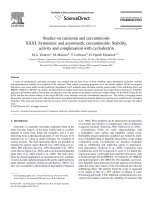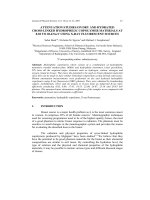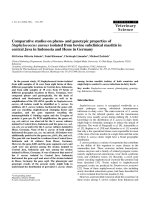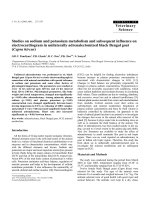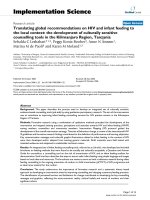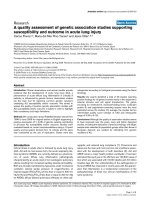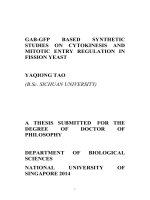Genetic diversity studies on parental and interspecific hybrids (Gossypium hirsutum L. × Gossypium barbadense L.) of cotton
Bạn đang xem bản rút gọn của tài liệu. Xem và tải ngay bản đầy đủ của tài liệu tại đây (387.85 KB, 7 trang )
Int.J.Curr.Microbiol.App.Sci (2019) 8(4): 263-269
International Journal of Current Microbiology and Applied Sciences
ISSN: 2319-7706 Volume 8 Number 04 (2019)
Journal homepage:
Original Research Article
/>
Genetic Diversity Studies on Parental and Interspecific Hybrids
(Gossypium hirsutum L. × Gossypium barbadense L.) of Cotton
S. Malathi1* and Rajesh S. Patil2
1
College of Agriculture, Dharwad, 2Agriculture Research Station, Dharwad Farm, University
of Agricultural Sciences, Dharwad, India
*Corresponding author
ABSTRACT
Keywords
Genetic diversity,
Mahalanobis D2
statistic, Cluster,
and Triple cross
hybrids
Article Info
Accepted:
04 March 2019
Available Online:
10 April 2019
Genetic diversity analysis was conducted at Main Agricultural Research Station,
University of Agricultural Sciences, Dharwad during Kharif, 2017. In this study, 35
genotypes were evaluated for 11 yield and yield attributing traits and grouped into four
clusters through Mahalanobis D2 statistic. Cluster I was the biggest with 23 genotypes
followed by cluster II, III and IV. Among eleven characters studied, seed cotton yield
(25.38 %) and days to 50 per cent flowering (22.86 %), contributed high for divergence
while other characters like boll weight (0.34 %), number of sympodia per plant (0.5 %)
and lint index (0.67 %) contributed very little for divergence. Cluster IV with solitary
genotype secured 1st rank with an overall score of 20 across 13 characters and the cluster
III obtained 4th rank with an overall score of 34. As high inter-cluster distance is shown by
cluster III and IV, hence is desirable to select genotypes from these clusters to develop
triple cross hybrids for further crop improvement programs.
of which are generally cultivated species. Out
of the four cultivated species, Gossypium
hirsutum L. and Gossypium barbadense L. are
tetraploids (2n=4x=52) and are commonly
called as new world cottons. Whereas,
Gossypium arboreum L. and Gossypium
herbaceum L. are diploids (2n=2x=26) and
known as old world cottons. India is the only
country, where all four cultivated species of
cotton viz., G. herbaceum, G. arboreum, G.
hirsutum and G. barbadense are grown. In
India, the crop is being grown in area of 12.3
million hectares, producing 28.50 million
bales with a productivity of 504 kg ha-1. In
Karnataka, cotton is being grown in area of
Introduction
Cotton the king of fibre reside one of the
momentous and important cash crop
exercising profound influence on economics
and social affairs of the world. The word
“cotton” derived from the Arabic word “al
qatan” and popularly known as “White Gold”.
Cotton plays vital role in Indian economy as it
is the backbone of textile industry. The
Gossypium species were domesticated in both
the old and new world. It supplies products
such as lint, oil, seed meal, hulls and linters.
The genus Gossypium, a member of the
Malvaceae family, consists of 50 species, four
263
Int.J.Curr.Microbiol.App.Sci (2019) 8(4): 263-269
5.65 lakh hectares with production and
productivity of 19.0 lakh bales and 572 kg
ha-1 respectively (Anon., 2018). For an
outstanding breeding program in the crop
improvement, diversity analysis greatly helps
the breeder in the identification and proper
choice of parents for specific breeding
objectives. The present study was to assess
the genetic diversity among genotypes of
cotton.
hybrids as reported by Antonio et al.(2016) in
tomato.
Results and Discussion
The genetic diversity among 35 genotypes
was measured by employing D2 statistics and
grouped into four clusters using Tocher’s
method as given by Rao (1952). Distribution
of genotypes in each cluster is presented in
Table 2 and Figure 1. Similar genetic
diversity works were carried out on this crop
by Sambamurthy et al. (2004), Satish et al.
(2009), Shakthi et al. (2009) and Kulkarni et
al. (2011). Cluster I was found largest with 23
genotypes followed by cluster II comprising
six genotypes, while cluster III comprised of
five genotypes and cluster IV includes a
solitary hybrid. The inter-cluster and intracluster D2 values were estimated and have
been presented in Table 3. The maximum
intra cluster distance was recorded within
cluster III (13.91) which had only parents,
while it was lowest in cluster IV as it included
only one hybrid (CPD-462×SB-YF-425),
indicating that the genotypes of these
respective clusters might be differing
marginally in their genetic architecture.
Materials and Methods
The experimental material consisted of 35
genotypes comprising of eight lines, three
testers (Table 1) and their resultant twenty
four hybrids produced by line x tester mating
design. The experimental material was sown
in Randomised Block Design with three
replications during Kharif, 2017-18 at
Agricultural Research Station Dharwad.
Three rows of each 4.2 m length was assigned
to each genotype with plants having 60 cm
intra spacing and 90 cm inter row spacing.
Five plants were randomly selected from each
replication for each genotype and the average
value for each plot was computed for plant
height, number of monopodia, number of
sympodia, boll weight, number of bolls per
plant, ginning outturn, seed index and seed
cotton yield whereas lint index was calculated
on formula basis. The development of
potential hybrids depends on selecting
superior parents possessing higher directional
dominance, genetic diversity and allelic
differences for most of the traits. Of these, the
genetic divergence can be estimated by an
effective statistical tool, Mahalanobis D2
statistic that gives an estimate about the
diverse nature of the parents.
The maximum inter cluster distance was
observed between cluster III and cluster IV
(76.21) followed by cluster I and cluster III
(42.67). The genotypes belonging to clusters
III and cluster IV possess highest inter cluster
distance, suggesting that hybridization
between the parents of these respective
divergent clusters may lead to higher
magnitude of heterosis for the characters
concerned. Significant level of desired
heterosis is achieved whenever parents with
moderate divergence are used for crossing.
(Arunachalam et al., 1984)
In this experiment genetic diversity was
assessed among genotypes consisting of both
hybrids and parents, to determine the best
possible triple cross hybrids and double cross
From this exercise it was clear that the lines
which were selected for experiment got
included in two different clusters, cluster II
264
Int.J.Curr.Microbiol.App.Sci (2019) 8(4): 263-269
and cluster III, where as all the testers were
under the single cluster, i.e cluster III. The
inter cluster distance between clusters II and
III was considerably high, hence the high
yielding hybrids such as CPD-462×SB-YF425, FLT-36×SB-YF-425, FLT-31×SB-YF425, FLT-31×BCS 23-18-7, CPD-462×BCS
23-18-7 resulted from the parental genotypes
from cluster II and III. Similar results were
found by Pushpam et al. (2004), Gopinath et
al., (2009), and Xian Tao et al., (2011).
III (6.66) recorded highest and lowest means
for the trait total number of bolls per plant,
respectively. Genotypes of highest lint index
were found to be under cluster III (6.04 g) and
lowest under cluster II (10.62 g). The ginning
outturn mean values were highest for
genotypes falling under cluster II (35.38 %)
and lowest in cluster III (33.31 %). Cluster I
(42.22 cm) and cluster II (38.88 cm) had
highest and lowest sympodial length at 50 per
cent plant height, respectively. The low seed
index genotypes were categorised under
cluster II (10.62 g), while highest were under
cluster III (11.97 g). The cluster II (948.83
kg/ha) mean for the seed cotton yield is
highest where as the genotypes of cluster III
(194.24 kg/ha) had lowest mean value.
Among 11 characters studied, the genotypes
in cluster II had maximum values for boll
weight, plant height, number of monopodia
per plant, number of bolls per plant, ginning
outturn and seed cotton yield. Cluster I had
maximum values for number of sympodia per
plant, sympodial length at 50 per cent plant
height and cluster III had highest mean values
for days to 50 per cent flowering, seed index
and lint index. Analysis of cluster means
indicated substantial variation among the four
clusters formed. In the present study clusters I
and IV included high yielding hybrids,
whereas cluster II and cluster III included
parental genotypes. The different genetic
make up of parents and hybrids has shown up
in differential clustering.
Cluster means of 11 yield and yield
contributing characters were assessed and are
presented in Table 4. The mean comparison
of the different characters indicated
considerable differences among the clusters
for all the characters. The genotypes in cluster
II had minimum days to 50 per cent flowering
and maximum days to 50 per cent flowering
was found in genotypes falling under cluster
III. With respect to the trait boll weight, the
genotypes possessing highest boll weight fell
under cluster II (4.34 g) and genotypes with
lowest boll weight fell under cluster III (3.10
g). Tall types were found in cluster II (138.42
cm) and dwarf types in cluster III (120.60
cm). The parental lines possessing less
number of monopodia per plant were included
under cluster III (1.12) while highest number
in cluster II (1.68).The genotypes in cluster I
(23.89) had the highest number of sympodia
while cluster III (20.53) genotypes had the
lowest number. Cluster II (16.91) and cluster
Table.1 Experimental material used in the study
Lines (G. hirsutum L.)
1. FLT-36
2. FLT-44
3. FLT-31
4. FLT-28
5. SG-1
6. SG-2
7. EL-4
8. CPD-462
Testers (G. barbadense L.)
1. BCS-23-18-7
2. GIZA-70
3. SBYF-425
265
Int.J.Curr.Microbiol.App.Sci (2019) 8(4): 263-269
Table.2 Distribution of genotypes into clusters considering both hybrids and parents together
Sl. No.
Cluster
1
I
Number of
genotypes
23
Name of genotype
FLT-36 × BCS-23-18-7, FLT-36 × GIZA-70, FLT-36 × SB-YF-425, FLT-44 × BCS-23-18-7, FLT-44 × GIZA-70, FLT44 × SB-YF-425 , FLT-31 × BCS-23-18-7, FLT-31 × GIZA-70, FLT-31 × SB-YF-425, FLT-28 × BCS-23-18-7, FLT-28
× GIZA-70, FLT-28 × SB-YF-425, SG-1 × BCS-23-18-7, SG-1 × GIZA-70, SG-1 × SB-YF-425, SG-2 × BCS-23-18-7,
SG-2 × GIZA-70, SG-2 × SB-YF-425, CPD-462 × BCS-23-18-7, CPD-462 × GIZA-70
2
II
6
FLT-36,FLT-31, FLT-28, FLT-33, EL-4, CPD-462
3
III
5
BCS-23-18-7,GIZA-70,SB-YF-425, SG-1, SG-2
4
IV
1
CPD-462 × SB-YF-425
Table.3 Average intra and inter cluster distance values considering both hybrids and parents together
Clusters
I
II
III
IV
I
7.38
II
24.69
8.07
III
42.67
39.75
13.91
IV
22.47
33.49
76.21
0.00
Table.4 Cluster means considering both hybrids and parents together
Cluster
Days to
50 %
flowering
Boll
weight
(g)
Plant
height
(cm)
Number of
monopodia
per plant
I
77.54
(3)
78.67
(2)
96.00
(1)
77.33
(4)
3.75
(3)
4.24
(1)
3.43
(4)
4.07
(2)
162.20
(1)
132.79
(3)
127.23
(4)
158.07
(2)
1.97
(2)
1.39
(3)
1.14
(4)
2.36
(1)
II
III
IV
Number
of
sympodia
per plant
22.92
(2)
22.72
(4)
22.91
(3)
24.13
(1)
Number
of bolls
per
plant
25.15
(2)
13.89
(3)
8.80
(4)
34.00
(1)
266
Sympodial
length at 50
% plant
height (cm)
50.89
(1)
41.48
(3)
40.89
(4)
48.55
(2)
Ginning
outturn
(%)
Seed
index
(g)
Lint
index
(g)
30.50
(4)
34.60
(1)
34.49
(2)
31.70
(3)
12.88
(2)
10.52
(4)
11.63
(3)
12.95
(1)
5.68
(3)
5.58
(4)
6.16
(1)
6.01
(2)
Seed
cotton
yield
(kg/ha)
582.05
(3)
825.66
(2)
289.66
(4)
1239.38
(1)
Cluster
score
Cluster
rank
26
II
30
III
34
IV
20
I
Int.J.Curr.Microbiol.App.Sci (2019) 8(4): 263-269
Table.5 Per cent contribution of characters towards divergence
Sl. No.
1
2
3
4
5
6
7
8
9
10
11
Characters
Characters contribution (%) considering
both parents and hybrids
22.86
7.23
0.34
8.24
0.50
12.10
2.69
Days to 50 % flowering
Plant height
Boll weight
Number of monopodia per plant
Number of sympodia per plant
Number of bolls per plant
Sympodial length at 50 % plant
height
Ginning outturn
Lint index
Seed index
Seed cotton yield
2.18
17.82
0.67
25.38
Fig.1 Cluster grouping considering parents and hybrids using Tocher method
267
Int.J.Curr.Microbiol.App.Sci (2019) 8(4): 263-269
maximum towards the D2 values needed to be
given more emphasis for deciding the clusters
to be taken for the purpose of choice of
parents for hybridization.
All 36 genotypes spread over 6 clusters were
scored based on their means across the
clusters for all the 13 characters, as given in
Table 4. The highest cluster mean with
respect to particular character was given the
first rank and next cluster possessing next best
means were given 2nd, 3rd and so on up to
6th rank for all the traits. Finally, the clusters
are ranked based on the overall score obtained
from 13 characters. The lowest scoring cluster
was given the first rank, and next cluster
possessing the score above the previous ones
were given 2nd, 3rd and so on up to 6th rank.
Accordingly, cluster IV with an overall score
of 20 across the 13 characters elected the first
rank followed by cluster I, II and III,
indicating presence of most promising
genotypes in them and further breeding
programme to generate new material. Cluster
III stood highest with an overall score of 34.
Similar work was reported by Bhaganna et
al., (2017) in French bean.
In concluded as the inter-cluster distance was
found to be highest between clusters III and
IV, hence, it could be expected that the cross
combinations involving hybrid in solitary
cluster IV and best parents of cluster III could
be used to develop triple cross hybrids for
future breeding programs. Since hybrid CPD462 × SB-YF-425 formed a solitary cluster
(IV) apart from remaining 23 hybrids in
cluster (I), it could indicate an opportunity for
developing best double cross hybrids
involving CPD-462 × SB-YF-425 with any
good hybrid of cluster I. Similar result was
reported by Antonio et al. (2016).
References
Anonymous, 2018, Annu. Rep. ICAR - All
India Coordinated Research Project on
cotton, 14(1): 2-5.
Antonio, T., Marcelo, V., Alexandre, P. and
Rosana, R., 2016, Prospecting of
tomato hybrids for table and industry
via mixed modeling and multivariate
analysis. Hortic. bras., 35: 20-25.
Arunachalam, V., Bandopadhya, A., Nigam,
S. N. and Gibbons, R. W., 1984,
Heterosis in relation to genetic
divergence and specific combining
ability
in
groundnut
(Arachis
hypogaea L.). Euphyt., 33: 33-39.
Bhaganna, H., Salimath, P. M., Aghora, TS.,
Nagarajappa, A. and Ganga Prasad S.,
2017, Genetic Diversity analysis by
D2 clustering of yield and yield
attributing traits in French bean
(Phaseolus
vulgaris
L.).
J.
Pharmacogn Phytochem.,6(6): 13311335
De, R. N., Seetharaman, R., Sinha, M.T. and
Banerjee,
S.P.
1988.
Genetic
The contribution of various characters
towards diversity is given in Table 5. Among
eleven characters studied, seed cotton yield
(25.38 %) and days to 50 per cent flowering
(22.86 %), contributed high for divergence
while other characters like boll weight (0.34
%), number of sympodia per plant (0.5 %)
and lint index (0.67 %) contributed very little
for divergence. The contribution of other
traits include plant height (7.23 %), number of
monopodia per plant (8.24 %), number of
bolls per plant (12.10 %), sympodial length at
50 per cent plant height (2.69 %), ginning
outturn (2.18 %) and lint index (17.82 %).
Among the eleven characters studied, the
maximum contribution to the total divergence
was by seed cotton yield followed by number
of bolls per plant and lint index. The above
results imply that in order to select genetically
diverse hybrids, selection strategy should be
based on the traits like seed cotton yield,
number of bolls per plant and lint index. De et
al. (1988) stated that traits contributing
268
Int.J.Curr.Microbiol.App.Sci (2019) 8(4): 263-269
divergence in rice. Indian J Genet
Plant Breed., 48 : 189-194.
Gopinath, M., Rajamani, S., Krishna Naik, R.
and Mallikarjuna R. C., 2009, Genetic
divergence for lint characters for
upland cotton (Gossypium hirsutum
L.). J. Cotton Res. Dev., 23 (1): 46-48.
Kulkarni, A. A., Nanda, H. C. and Patil, S. G.,
2011, Studies on genetic divergence in
upland cotton (Gossypium hirsutum
L.). J. cotton Res. Dev., 25 (1): 9-13.
Mahalanobis, P. C., 1936, A statistical study
at Chinese head measurement. J.
Asiatic Sco. Bengal., 25: 301-377.
Pushpam, R., Raveendran, T. S., Devasena,
N. and Ravikesavan, R., 2004, Studies
on genetic diversity in upland cotton
(Gossypium hirsutum) J. Indian Soc.
Cotton Improv., 29 (2): 135-143.
Rao, C. R., 1952, Advanced Statistical
Methods in Biometrical Research,
John Wiley & Sons. Inc., New York,
pp. 357-363.
Sambamurthy, J. S. V., Chamundeswari, N.
and Udagasree, P., 2004, Studies on
genetic divergence in introgressed
lines of upland cotton (Gossypium
hirsutum L.). Paper presented in: Int.
Symp. Strat. Sust. Cotton Prod. – A
Global Vision. 1. Crop Improv., 23-25
November, 2004, held at Uni. Agric.
Sci., Dharwad, pp. 125-129.
Satish, Y., Jain, P. P. and Chhabra, B. S.,
2009, Studies on genetic diversity in
upland cotton (G. hirsutum L.). J.
Cotton Res. Dev., 23 (1): 18-22.
Shakthi. A. R., Kumar, M. and Ravikesavan.
R., 2009, Genetic diversity in cotton
(G. hirsutum L.). Adv. Plant Sci.,
22(1): 285-291.
XianTao, A., XueYuan, L., JunDuo W.,
JuYun, Z., Hong, S., Tuerxunjiang.,
LiKun, D. and Ming, M., 2011,
Genetic diversity of agronomic
phenotypes in upland cotton varieties
of north Xinjiang area. Mol. Plant.
Breed., 9 (1): 113-122.
How to cite this article:
Malathi, S. and Rajesh S. Patil. 2019. Genetic Diversity Studies on Parental and Interspecific
Hybrids (Gossypium hirsutum L. × Gossypium barbadense L.) of Cotton.
Int.J.Curr.Microbiol.App.Sci. 8(04): 263-269. doi: />
269



